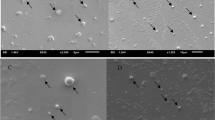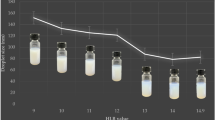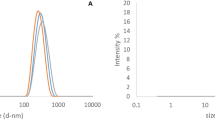Abstract
Bemisia tabaci is an agricultural pest of worldwide distribution that causes serious damage to several crops. It is of crucial importance to control this pest, especially for large-scale production. Accordingly, formulations based on essential oils of pesticidal action are potentially promising in the agricultural sector. Additionally, the nanoencapsulation of these bioactive compounds promotes their protection from environmental degradation and prolongs their biological activity. Here, we develop PCL (poly-ε-caprolactone) nanoparticles containing essential oils of Xylopia aromatica leaves and fruits and evaluate their insecticidal effect in B. tabaci Middle East Asia Minor 1 biotype B. The average yields of essential oils from leaves and fruits of X. aromatica were 0.05 and 0.80%, respectively. The major compounds in the essential oil of leaves were bicyclogermacrene (44.80%), α-pinene (8.23%) and β-pinene (7.75%) while in fruits were α-pinene (35.40%), β-phellandrene (31.05%) and β-pinene (22.51%). The PCL nanoparticles containing the essential oils exhibited encapsulation efficiency of 95% and particle diameter smaller than 500 nm. Biodegradable nanospheres substantially protected the essential oils from accelerated degradation caused by UV light and also prevented possible phytotoxic activity of the in natura essential oil from leaves of X. aromatica in high concentrations, probably due to the gradual release. In natura and nanoencapsulated essential oils from leaves and fruits decreased (up to 98%) the oviposition of B. tabaci in common bean leaves. Our results indicate that both in natura and nanoencapsulated oils of X. aromatica may potentially be used as alternative to the chemical control of B. tabaci.
Graphic abstract









Similar content being viewed by others
References
Abbott WS (1925) A method of computing the effectiveness of an insecticide. J Econ Entomol 18:2. https://doi.org/10.1093/jee/18.2.265a
Abreu FOMS, Oliveira EF, Paula HCB, De Paula RCM (2012) Chitosan/cashew gum nanogels for essential oil encapsulation. Carbohydr Polym 89:1277–1282. https://doi.org/10.1016/j.carbpol.2012.04.048
Adams RP (2007) Identification of essential oil components by gas chromatography/quadrupole mass spectroscopy, 4th edn. Allured Publishing, Carol Stream
Ahlin P, Kristl J, Kristl A, Vrecer F (2002) Investigation of polymeric nanoparticles as carriers of enaprilat for oral administration. Int J Pharm 239:113–120. https://doi.org/10.1016/S0378-5173(02)00076-5
Amri I, Gargouri S, Hamrouni L, Hanana M, Fezzani T, Jamoussi B (2012) Chemical composition, phytotoxic and antifungal activities of Pinus pinea essential oil. J Pest Sci 85:199–207. https://doi.org/10.1007/s10340-012-0419-0
Amri I, Hamrouni L, Hanana M, Jamoussi B (2013) Reviews on phytotoxic effects of essential oils and their individual components: news approach for weeds management. Int J Appl Biol Pharm Technol 4:96–114
Andrade EHA, Silva ACM, Carreira LMM, Oliveira J, Maia JGS (2004) Essential oil composition from leaf, fruit and flower of Xylopia aromatica (Lam.) Mart. J Essent Oil-Bear Plants 7:151–154. https://doi.org/10.1080/0972-060X.2004.10643382
Andrade LH, Oliveira JV, Lima IMM, Santana MF, Breda MO (2013) Efeito de repelência de azadiractina e óleos essenciais sobre Aphis gossypii Glover (Hemiptera: Aphidae) em algodoeiro. Rev Ciênc Agron 44:628–634. https://doi.org/10.1590/S1806-66902013000300027
Ateyyat MA, Al-Mazra’awi M, Abu-rjai T, Shatnawi MA (2009) Aqueous extracts of some medicinal plants are as toxic as Imidacloprid to the sweet potato whitefly, Bemisia tabaci. J Insect Sci 9:15–20. https://doi.org/10.1673/031.009.1501
Bakkali F, Averbeck S, Averbeck D, Idaomar M (2008) Biological effects of essential oils—a review. Food Chem Toxicol 46:446–475. https://doi.org/10.1016/j.fct.2007.09.106
Baldin ELL, Crotti AEM, Wakabayashi KAL, Silva JPGF, Aguiar GP et al (2013) Plant-derived essential oils affecting settlement and oviposition of Bemisia tabaci (Genn.) biotype B on tomato. J Pest Sci 86:301–308. https://doi.org/10.1007/s10340-012-0462-x
Basit M, Saeed S, Saleem MA, Denholm I, Shah M (2013) Detection of resistance, cross-resistance, and stability of resistance to new chemistry insecticides in Bemisia tabaci (Homoptera: Aleyrodidae). J Econ Entomol 106:1414–1422. https://doi.org/10.1603/EC12414
Batish DR, Setia N, Singh HP, Kohli RK (2004) Phytotoxicity of lemon-scented eucalypt oil and its potential use as a bioherbicide. Crop Prot 23:1209–1214. https://doi.org/10.1016/j.cropro.2004.05.009
Camargo MGG, Souza RM, Reys P, Morellato LPC (2011) Effects of environmental conditions associated to the cardinal orientation on the reproductive phenology of the cerrado savanna tree Xylopia aromatica (Annonaceae). An Acad Bras Ciênc 83:1007–1020. https://doi.org/10.1590/S0001-37652011005000014
Castillo-Sanchéz LH, Jiménez-Osornio JJ, Delgado-Herrera MA (2010) Secondary metabolites of the Annonaceae, Solanaceae and Meliaceae families used as biological control of insects. Trop Subtrop Agroecosyst 12:445–462
Cazo NA, Pereira-Filho ER, Silva MFGF, Fernandes JB, Vieira PC et al (2012) Nanopartículas de poli-ɛ-caprolactona carregadas com hidrocortisona: preparação usando planejamento factorial e sua avaliação. Orbital 4:54–76
Christofoli M, Costa ECC, Bicalho KU, Domingues VC, Peixoto MF (2015) Insecticidal effect of nanoencapsulated essential oils from Zanthoxylum rhoifolium (Rutaceae) in Bemisia tabaci populations. Ind Crop Prod 70:301–308. https://doi.org/10.1016/j.indcrop.2015.03.025
Coelho AAM, Paula JE, Espíndola LS (2009) Effect of Cerrado plant extracts on Dipetalogaster maxima (Uhler) (Hemiptera, Reduviidae). Rev Bras Entomol 53:444–451. https://doi.org/10.1590/S0085-56262009000300020
Corrêa JCR, Salgado HRN (2011) Atividade inseticida das plantas e aplicações: Revisão. Rev Bras Plantas Med 13:500–506. https://doi.org/10.1590/S1516-05722011000400016
Costa JT, Forim MR, Costa ES, De-Souza JR, Mondego JM, Boiça AL Jr (2014) Effects of different formulations of neem oil-based products on control Zobrotes subfasciatus (Boheman, 1833) (Coleoptera: Bruchidae) on beans. J Stored Prod Res 56:49–53. https://doi.org/10.1016/j.jspr.2013.10.004
De Feo V, De Simone F, Senatore F (2002) Potential allelochemicals from the essential oil of Ruta graveolens. Phytochemistry 61:573–578. https://doi.org/10.1016/s0031-9422(02)00284-4
Deletre E, Chandre F, Barkman B, Menut C, Martina T (2016) Naturally occurring bioactive compounds from four repellent essential oils against Bemisia tabaci whiteflies. Pest Manag Sci 72:179–189. https://doi.org/10.1002/ps.3987
Durigan G, Baitelo JB, Franco GADC, Siqueira MF (2004) Plantas do cerrado paulista: imagens de uma paisagem ameaçada. Instituto Florestal, São Paulo (in portuguese)
Faria J, Aragão F, Souza T, Quintela E, Kitajima E, Ribeiro S (2016) Golden mosaic of common beans in Brazil: management with a transgenic approach. APS Feature-2016-10
Fazolin M, Estrela JLV, Catani V, Alécio MR, Lima MS (2007) Atividade inseticida do óleo essencial de Tanaecium nocturnum (Brab. Rodr.) Bur. & K. Shum (Bignoniaceae) sobre Sitophilus zeamais Motsch. (Coleoptera: Curculionidae). Acta Amazonica 37:599–604
Ferraz RPC, Cardoso GMB, Da Silva TB, Fontes JEN, Prata APN et al (2013) Antitumour properties of the leaf essential oil of Xylopia frutescens Aubl. (Annonaceae). Food Chem 141:196–200. https://doi.org/10.1016/j.foodchem.2013.02.114
Fessi H, Puisieux F, Devissaguet JP, Ammoury N, Benita S (1989) Nanocapsule formation by interfacial deposition following solvent displacement. Int J Pharm 55:R1–R4. https://doi.org/10.1016/0378-5173(89)90281-0
Gilbertson RL, Batuman O, Webster CG, Adkins S (2015) Role of the insect Supervectors Bemisia tabaci and Frankliniella occidentalis in the emergence and global spread of plant viruses. Annu Rev Virol 2:67–93. https://doi.org/10.1146/annurev-virology-031413-085410
Grichi A, Nasr Z, Khouja ML (2016) Phytotoxic effects of essential oil from Eucalyptus lehmanii against weeds and its possible use as a bioherbicide. Bull Environ Pharmacol Life Sci 5:17–23
Hansted L, Jakobsen HB, Olsen CE (1994) Influence of temperature on the rhythmic emission of volatiles from Ribes nigrum flowers in situ. Plant Cell Environ 17:1069–1072. https://doi.org/10.1111/j.1365-3040.1994.tb02030.x
Hoet S, Stévigny C, Hérent MF, Quetin-Leclercq J (2006) Antitrypanosomal compounds from leaf essential oil of Strychnos spinosa. Planta Med 72:480–482. https://doi.org/10.1055/s-2005-916255
Horowitz AR, Ishaaya I (2014) Dynamics of biotypes B and Q of the whitefly Bemisia tabaci and its impact on insecticide resistance. Pest Manag Sci 70:1568–1572. https://doi.org/10.1002/ps.3752
Ikbal C, Pavela R (2019) Essential oils as active ingredients of botanical insecticides against aphids. J Pest Sci 92:971–986. https://doi.org/10.1007/s10340-019-01089-6
Ipek E, Zeytinoglu H, Okay S, Tuylu BA, Kurkcuoglu M, Baser KHC (2005) Genotoxicity and antigenotoxicity of Origanum oil and carvacrol evaluated by Ames Salmonella/microsomal test. Food Chem 93:551–556. https://doi.org/10.1016/j.foodchem.2004.12.034
Ishaaya I, Horowitz AR (1995) Pyriproxyfen, a novel insect growth regulator for controlling whiteflies: mechanism and resistance management. Pestic Sci 43:227–232
Isman MB (2006) Botanical insecticides, deterrents and repellents in modern agriculture and increasingly regulated world. Annu Rev Entomol 51:45–66. https://doi.org/10.1146/annurev.ento.51.110104.151146
Kaur S, Singh HP, Mittal S, Batish DR, Kohli RK (2010) Phytotoxic effects of volatile oil from Artemisia scoparia against weeds and its possible use as a bioherbicide. Ind Crops Prod 32:54–61. https://doi.org/10.1016/j.indcrop.2010.03.007
Kéita SM, Vincent C, Schmit JP, Arnason JT, Belanger A (2001) Efficacy of essential oil of Ocimum basilicum L. and O. gratissimum L. applied as an insecticidal fumigant and powder to control Callosobruchus maculates (Fabr.) (Coleoptera: Bruchidae). J Stored Prod Res 37:339–349. https://doi.org/10.1016/s0022-474x(00)00034-5
Koul O, Walia S, Dhaliwal EGS (2008) Essential oils as green pesticides: potential and contraints. Biopestic Int 4:63–84
Krisnki D, Massaroli A, Machado M (2014) Potencial inseticida de plantas da família Annonaceae. Rev Bras Frutic 36:225–242. https://doi.org/10.1590/S0100-29452014000500027
Kumar P, Poehling HM, Borgemeister C (2005) Effects of different application methods of azadirachtin against sweetpotato whitefly Bemisia tabaci Gennadius (Hom., Aleyrodidae) on tomato plants. J Appl Entomol 129:489–497. https://doi.org/10.1111/j.1439-0418.2005.01009.x
Kumar S, Bhanjana G, Sharma A, Sidhu MC, Dilbaghi N (2014) Synthesis, characterization and field evaluation of pesticide loaded sodium alginate nanoparticles. Carbohydr Polym 101:1061–1067. https://doi.org/10.1016/j.carbpol.2013.10.025
Kyarimpa CM, Böhmdorfer S, Wasswa J, Kiremire BT, Ndiege IO, Kabasa JD (2014) Essential oil and composition of Tagetes minuta from Uganda. Larvicidal activity on Anopheles gambiae. Ind Crops Prod 62:400–404. https://doi.org/10.1016/j.indcrop.2014.09.006
Lago JHG, Ávila P Jr, Moreno PRH, Limberger RP, Apel MA, Henriques AT (2003) Analysis, comparison and variation on the chemical composition from the leaf volatile oil of Xylopia aromatica (Annonaceae). Biochem Syst Ecol 31:669–672. https://doi.org/10.1016/s0305-1978(02)00267-3
Lee SE, Lee BH, Choi WS, Park BS, Kim JS, Campbell BC (2001) Fumigant toxicity of volatile natural products from Korea spices and medicinal plants towards the rice weevil, Sitophilus oryzae (L.). Pest Manag Sci 57:548–553. https://doi.org/10.1002/ps.322
Magenheim B, Benita S (1991) Nanoparticle characterization: a comprehensive physicochemical approach. J Pharm Sci 1:221–241
Maji TK, Baruah I, Dube S, Hussain MR (2007) Microencapsulation of Zanthoxylum limonella oil (ZLO) in glutaraldehyde crosslinked gelatin for mosquito repellent application. Bioresour Technol 98:840–844. https://doi.org/10.1016/j.biortech.2006.03.005
Marangoni C, Moura NF, Garcia FRM (2012) Utilização de óleos essenciais e extratos de plantas no controle de insetos. Rev Ciênc Ambient 6:95–112
Marques MA, Quintela ED, Mascarin GM, Fernandes PM, Arthus SP (2014) Management of Bemisia tabaci biotype B with botanical and mineral oils. Crop Prot 66:127–132. https://doi.org/10.1016/j.cropro.2014.09.006
Martinez SS (2002) O nim: Azadirachta indica—natureza, usos múltiplos, produção. Iapar, Londrina
Moreira JC, Jacob SC, Peres F, Lima JS, Meyer A et al (2002) Avaliação integrada do impacto do uso do agrotóxico sobre a saúde humana em uma comunidade agrícola de Nova Fribgurgo/RJ. Ciênc Saúde Coletiva 7:299–311. https://doi.org/10.1590/S1413-81232002000200010
Moreira IC, Roque NF, Vilegas W, Zalewski C, Lago JHG, Funasaki M (2013) Genus xylopia (Annonaceae): chemical and biological aspects. Chem Biodivers 10:1921–1943. https://doi.org/10.1002/cbdv.201100308
Nascimento PFC, Nascimento AC, Rodrigues CS, Antoniolli AA, Santos PO et al (2007) Antimicrobial activity of the essentials oils: a multifactor approach of the methods. Rev Bras Farmacogn 17:108–113. https://doi.org/10.1590/S0102-695X2007000100020
Navarro-Silva MA, Marques FA, Duque JEL (2009) Review of semiochemical that mediate the oviposition of mosquitos: a possible sustainable tool for the control and monitoring of Culicidae. Rev Bras Entomol 53:1–6. https://doi.org/10.1590/S0085-56262009000100002
Navas-Castillo J, Fiallo-Olive E, Sanchez-Campos S (2011) Emerging virus diseases transmitted by whiteflies. Annu Rev Phytopathol 49:219–248. https://doi.org/10.1146/annurev-phyto-072910-095235
Nguemtchouin MMG, Ngassoum MB, Ngamo LST, Gaudu X, Cretin M (2010) Insecticidal formulation based on Xylopia aethiopica essential oil and kaolinite clay for maize protection. Crop Protect 29:985–991. https://doi.org/10.1016/j.cropro.2010.06.007
Oliveira MRV, Henneberry TJ, Anderson P (2001) History, current status and collaborative research projects for Bemisia tabaci. Crop Prot 20:709–723. https://doi.org/10.1016/S0261-2194(01)00108-9
Oliveira VB, Ferreira AVM, Oliveira MC, Teixeira MM, Brandão MGL (2014) Effects of Xylopia aromatica fruit on metabolic and inflammatory dysfunction induced by high refined carbohydrate-containing diet in mice. Food Res Int 62:541–550. https://doi.org/10.1016/j.foodres.2014.03.066
Oliveira-Silva JJ, Alves SR, Inacio AF, Meyer A, Sarcinelli PN et al (2000) Cholinesterase activities determination in frozen blood samples: an improvement to the occupational monitoring in developing countries. Hum Exp Toxicol 19:173–177. https://doi.org/10.1191/096032700678827762
Palumbo JC, Horowitz AR, Prabhaker N (2001) Insecticidal control and resistance management for Bemisia tabaci. Crop Prot 20:739–765. https://doi.org/10.1016/S0261-2194(01)00117-X
Paula HCB, Sombra FM, Cavalcante RF, Abreu FOMS, Paula RCM (2011) Preparation and characterization of chitosan/cashew gum beads loaded with Lippia sidoides essential oil. Mater Sci Eng, C 31:173–178. https://doi.org/10.1016/j.msec.2010.08.013
Pavarini DP, Pavarini SP, Niehues M, Lopes NP (2012) Exogenous influences on plant secondary metabolite levels. Anim Feed Sci Technol 176:5–16. https://doi.org/10.1016/j.anifeedsci.2012.07.002
Pavela R, Benelli G (2016) Essential oils as ecofriendly biopesticides? Challenges and constraints. Trends Plant Sci 21:1000–1007. https://doi.org/10.1016/j.tplants.2016.10.005
Pavela R, Sedlák P (2018) Post-application temperature as a factor influencing the insecticidal activity of essential oil from Thymus vulgaris. Ind Crops Prod 113:46–49. https://doi.org/10.1016/j.indcrop.2018.01.021
Pereira K, Quintela ED, Silva D, Nascimento V, Rocha D, Silva J, Forim M, Silva F, Cazal C (2018) Characterization of nanospheres containing Zanthoxylum riedelianum fruit essential oil and their insecticidal and deterrent activities against Bemisia tabaci (Hemiptera: Aleyrodidae). Molecules 23:E2052. https://doi.org/10.3390/molecules23082052
Pinheiro PV, Quintela ED, Oliveira JP, Seraphin JC (2009) Toxicity of neem oil to Bemisia tabaci biotype B nymphs reared on dry bean. Pesq Agrop Bras 44:354–360
Pinto NOF, Rodrigues THS, Pereira RCA, Silva LMAS, Cáceres CA et al (2016) Production and physico-chemical characterization of nanocapsules of the essential oil from Lippia sidoides Cham. Ind Crops Prod 86:279–288. https://doi.org/10.1016/j.indcrop.2016.04.013
Pontes WJT, Oliveira JCS, Câmara CAG, Gondim-Júnior MGC, Oliveira JV, Schwartz MOE (2007) Atividade acaricida dos óleos essenciais de folhas e frutos de Xylopia sericea sobre o ácaro rajado. Quim Nova 30:838–841. https://doi.org/10.1590/S0100-40422007000400015
Quintela ED, Abreu AG, Lima JFDS, Mascarin GM, Santos JBD, Brown JK (2016) Reproduction of the whitefly Bemisia tabaci (Hemiptera: Aleyrodidae) B biotype in maize fields (Zea mays L.) in Brazil. Pest Manag Sci 72:2181–2187. https://doi.org/10.1002/ps.4259
Qureshi MS, Midmore DJ, Syeda SS, Reid DJ (2009) Pyriproxyfen controls silverleaf whitefly, Bemisia tabaci (Gennadius), biotype B (Homoptera: Aleyrodidae) (SLW) better than buprofezin in bitter melons Momordica charantia L. (Cucurbitaceae). Aust J Entomol 48:60–64. https://doi.org/10.1111/j.1440-6055.2008.00684.x
Rambow C, Panichi VBS, Figueiredo JAS (2014) Risco: a percepção da comunidade ribeirinha do Rio dos Sinos em relação ao uso de defensivos agrícolas. Reget 18:796–802
Rao PJ, Kumar KM, Singh S, Subrahmanyam B (1999) Effect of Artemisia annua oil on development and reproduction of Dysdercus koenigii F. (Hem., Pyrrhocoridae). J Appl Entomol 123:315–318. https://doi.org/10.1046/j.1439-0418.1999.00341.x
Regnault-Roger C, Vincent C, Arnasson JT (2012) Essential oil in insect control: low-risk products in high-stakes world. Annu Rev Entomol 57:405–424. https://doi.org/10.1146/annurev-ento-120710-100554
Rodrigues AMS, De Paula JE, Degaller N, Molez JF, Espíndola LS (2006) Larvicidal activity of some Cerrado plant extracts against Aedes aegypti. J Am Mosq Control Assoc 22:314–317. https://doi.org/10.2987/8756-971X(2006)22%5b314:LAOSCP%5d2.0.CO;2
Roel AR (2001) Utilização de plantas com propriedades inseticidas: uma contribuição para o desenvolvimento rural sustentável. Interações Rev Int Desenv Local 1:43–50
Schaffazick SR, Rohlmann AR, Freitas LL, Guterres SS (2002) Caracterização e estudo de suspensões de nanocápsulas e nanoesferas poliméricas contendo diclofenaco. Acta Farm Bonaerense 21:99–106
Schaffazick SR, Guterres SS, Freitas LL, Pohlmann AR (2003) Caracterização e estabilidade físico-química de sistemas poliméricos nanoparticulados para a administração de fármacos. Quím Nova 26:726–737. https://doi.org/10.1590/S0100-40422003000500017
Simões CMO, Spitzer V (2000) Óleos voláteis. Simões CMO, Schenkel EP, Gosmann G, Mello JCP, Mentz LA, Petrovick PR (org) Farmacognosia: da planta ao medicamento, 2nd edn. UFRGS, Porto Alegre, pp 387–413
Singh P, Pandey AK (2018) Prospective of essential oils of the genus Mentha as biopesticides: a review. Front Plant Sci 9:1295. https://doi.org/10.3389/fpls.2018.01295
Soppimath KS, Aminabhavi TM, Kulkarni AR, Rudzinski WE (2001) Biodegradable polymeric nanoparticles as drug delivery devices. J Control Release 70:1–20. https://doi.org/10.1016/S0168-3659(00)00339-4
Stansly PA, Natwick ET (2010) Integrated systems for managing Bemisia tabaci in protected on open field agriculture. In: Stansly PA, Naranjo SE (eds) Bemisia: bionomics and management of a global pest. Springer, Amsterdam, pp 467–489
Stashenko EE, Jaramillo BE, Martínez JR (2004) Analysis of volatile secondary metabolites from Colombian Xylopia aromatica (Lamarck) by different extraction and headspace methods and gas chromatography. J Chromatogr A 1025:105–113. https://doi.org/10.1016/j.chroma.2003.10.059
Viegas C Jr (2003) Terpenos com atividade inseticida: uma alternativa para o controle químico de insetos. Quím Nova 26:390–400. https://doi.org/10.1590/S0100-40422003000300017
Yang N, Li A, Wan F, Liu W, Johnson D (2010) Effects of plant essential oils on immature and adult sweet potato whitefly, Bemisia tabaci biotype B. Crop Prot 29:1200–1207. https://doi.org/10.1016/j.cropro.2010.05.006
Yatagai M (1997) Miticidal activities of tree terpenes. Curr Top Phytochem 1:85–97
Acknowledgements
The authors thank José Francisco Arruda e Silva and Ana Lucia Delalibera de Faria, Embrapa Rice and Beans, for assistance with the statistical analyses and cited references, respectively. This work was made possible through financial support from the Coordenação de Aperfeiçoamento de Pessoa de Nível Superior (Capes); Fundação de Amparo à Pesquisa do Estado de Goiás (FAPEG), Conselho Nacional de Desenvolvimento Científico Tecnológico (CNPq), Ministério da Educação (MEC), Secretaria de Educação Profissional e Tecnológica (SETEC), Instituto Federal de Educação, Ciência e Tecnologia Goiano (IF Goiano) and the Instituto Federal de Educação, Ciência e Tecnologia do Sudeste de Minas Gerais (IF Sudeste MG). Research fellowship granted by CNPq—Brazil—to WLA is also gratefully acknowledged.
Author information
Authors and Affiliations
Corresponding author
Additional information
Communicated by A.R. Horowitz.
Publisher's Note
Springer Nature remains neutral with regard to jurisdictional claims in published maps and institutional affiliations.
Rights and permissions
About this article
Cite this article
Peres, M.C., de Souza Costa, G.C., dos Reis, L.E.L. et al. In natura and nanoencapsulated essential oils from Xylopia aromatica reduce oviposition of Bemisia tabaci in Phaseolus vulgaris. J Pest Sci 93, 807–821 (2020). https://doi.org/10.1007/s10340-019-01186-6
Received:
Revised:
Accepted:
Published:
Issue Date:
DOI: https://doi.org/10.1007/s10340-019-01186-6




